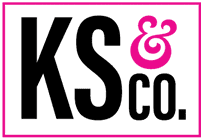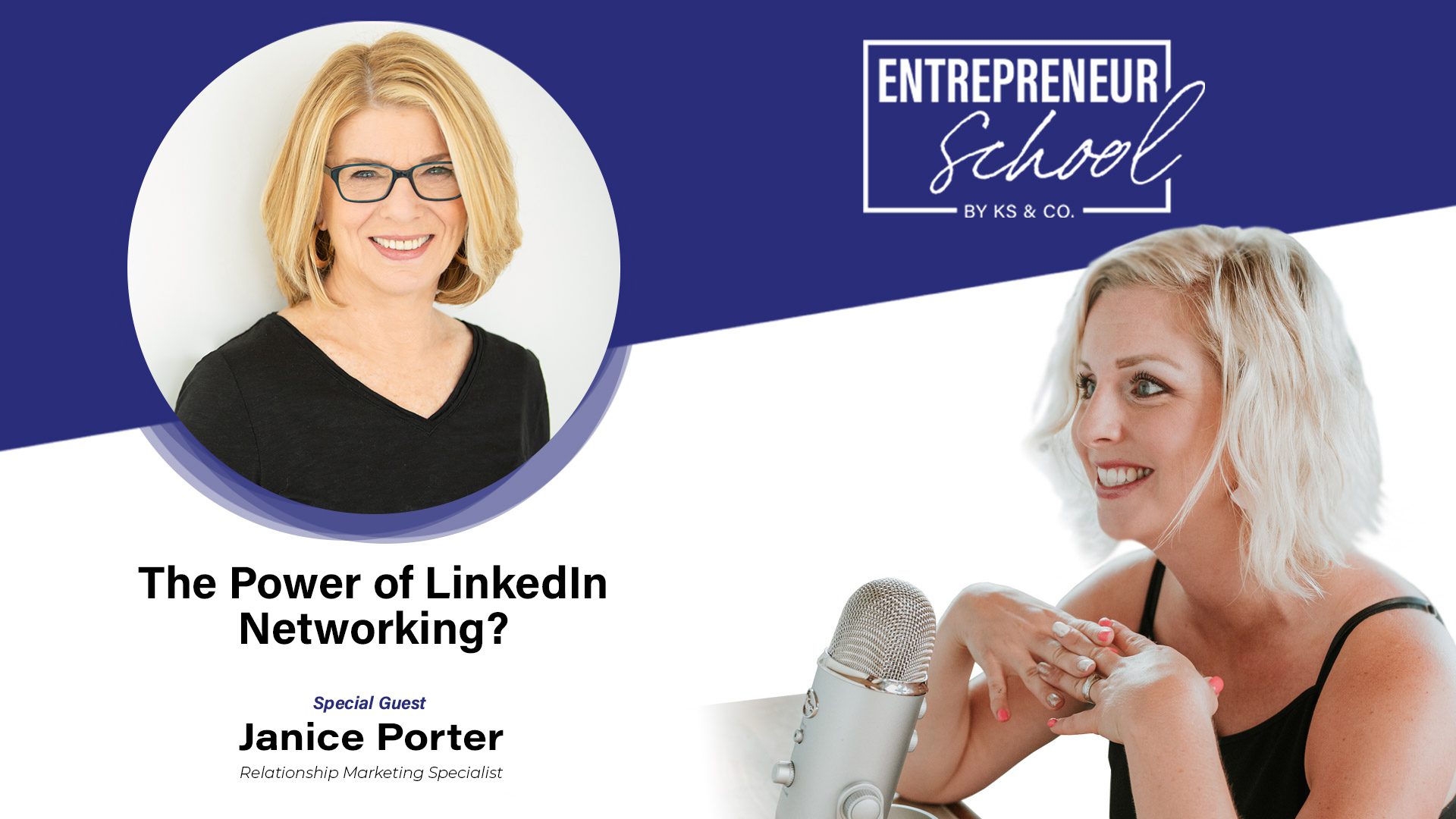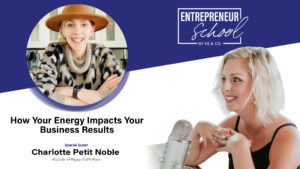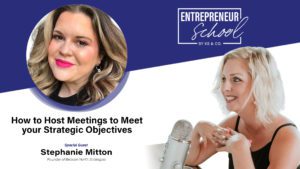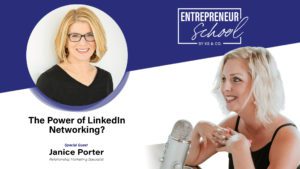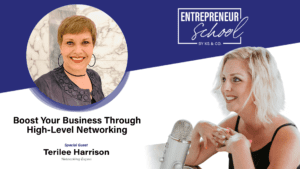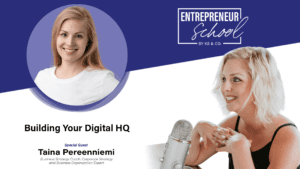We are here today to talk all about LinkedIn, this very underutilized tool to help you grow your business.
As an entrepreneur, it’s important to have a strong network. Your network can provide opportunities, advice, mentorship, and more. So how do you go about building your network? One great way is by using LinkedIn. LinkedIn is a business and employment-oriented service that operates via websites and mobile apps. It is mainly used for professional networking, including connecting with potential employers or employees. However, it can also be used for networking with other entrepreneurs in your field.
This week on Entrepreneur School we have Janice Porter, a LinkedIn trainer, relationship marketing specialist and podcast host. She believes that success in business all comes down to relationships and connection. Her training programs provide actionable steps to strengthen existing relationships and build new ones in a world where mass communication doesn’t cut it.
Are you using LinkedIn to generate leads and build your business? Janice Porter will discuss relationship marketing and outline the process she recommends building connections, stay connected and be remembered. Janice has successfully married online lead generation with effective offline follow-up communication to build long-term relationships and ultimately increase sales.
LinkedIn training is a huge part of Janice’s business – she believes anyone in business or looking for a new position, needs to have a professional LinkedIn profile, and that it is a powerful online platform for attracting new clients or being found by recruiters. It is also a valuable tool for building and strengthening one’s reputation and authority in his or her field.
I have had the pleasure of having Janice several times for different events that I’m doing. I’m going to let her introduce herself and then jump right on into the content and how we can engage with each other today in this workshop.
—
My name is Janice Porter, and I’m thrilled to be here. I am a relationship marketing specialist, and I say that because what I do is teach people how to use LinkedIn to build relationships. I think that makes me somewhat unique, but in that, a lot of people just train on how to build your profile, and then there you go. Or it’s about content, and for me, it’s about people.
I teach people, I encourage people to take those new connections that they make off LinkedIn and nurture them through a series of greeting cards and gifts that kind of disrupt the pattern of our usual text messaging and emailing, but send a real card in the mail, and that kind of draws their attention. It gets their attention a little bit more and then it’s about follow-up and all that good stuff. I’m a networker by trade. I’m a connector.
For me, it’s always about the people and the relationships and making them work. I also have a podcast called Relationships Rule.
So basically, and this is a little outdated, there are over 850 million people that are members of LinkedIn worldwide, and they are decision-makers. They are generally highly educated and have disposable income.
That’s something to keep in mind in comparison to the other platforms, however, and it skews higher mail than any of the other platforms do, but it’s pretty much just under and over 50%. In Canada, there are about 19 million users, and the US, of course, has the most, which is a third of their population, followed by India and China. But 19 million is more than half of our population, closer to a third of our population. So if you’re in business, if you are in business for yourself, you need to have a professional profile, and LinkedIn is the place to do that.
Maybe you’re new enough that you don’t even have a proper website yet. If you can have a free LinkedIn profile, that becomes your professional presence, for the time being, go for it, but make it the best it can be. LinkedIn is the largest business-to-business platform you can not only bring in more business, but you can get to the heart of business and conversations faster on this platform because it is a business platform. You can find collaborators here; you can find strategic business partners as well as find more referrals and connections.
You can build your credibility by being visible regularly and you can build your authority in your field by the information that you post and that you give value to people. And you can grow your network. I say that LinkedIn is not about selling, it’s about relationship building. It is a lead generation tool and I want to just show you the five steps to make LinkedIn work for you and then we’ll get down to the details.
You want to create your best first impression, be authentic, build relationships strategically, use the platform consistently and be visible to show your authority.
First Impression
Start by completing your profile. Include a professional headshot, your current position and employer, and a summary of your experience and skills.
I’m going to show you a few examples of the good, the bad and the ugly, I guess you would call it. These are the main things that you need to build on your profile, and they are what I call the three H’s. The header. The headshot. The headline.
Your About section, your Experience section, and now it’s good to have a Featured section and then there are some minor players in there like your volunteer work organizations you belong to publications you might have been printed in. Projects that you’ve worked on. Other things that will round out your profile and make people look for a common thread that they can have a conversation with you about.
This is what I call above the fold. The very first thing that people see is your header, which is the background image, your headshot and your headline which is the piece right under your name. So, you want to look at that first impression. By the way, people don’t even get 7 seconds anymore. It’s instant.

So which one looks better? The one that is more complete. This is the default background and it’s prime real estate. You should put something up there that speaks to your business. If you have a website, you might want it to be the same colour scheme and the same look as your website.
If you don’t, or if you are promoting a book you just wrote or if you are a speaker, it might be something that shows you on stage. However, don’t I encourage too much in the way of too many photographs up here because it messes with your headshot? Now, this headshot is a family photo, very cute, but it has nothing to do with her business. This is a little bit better but if I had this full screen for you, you would see that her husband’s shoulder is there right beside her. A professional headshot is the way to go.
It should be head and shoulders and it should show the whites of your eyes so you’re smiling through your eyes as well as smiling in the picture, of course. And then this shows her business. It also puts her website up there so it’s easy for people to see. And then a common mistake that people make when it comes to their headlines is saying they’re the owner or the president of the name of their company.
The only people that search on LinkedIn for owners or presidents or founders are people who want to sell you something for your business. Use this space wisely. It is, in my opinion, the most important real estate on LinkedIn.
Why? Because whenever you make a post that goes with you, your name and your headline, when you do a recommendation for somebody that goes with you, your name and your headline, when you comment on somebody else’s posts, that goes with you. There are all sorts of reasons why this needs to speak to your target audience and use keywords that people will be looking for to find somebody like you. In this case, Sandy is a retail gift consultant. She deals with corporate gifts and then her tagline or her not a tagline, her benefit statement is helping business professionals choose the perfect gift for their clients. That pretty much says who she serves and how she serves them.
How inviting is this? Or is this ten times more inviting? Sean was a great guy to work with. He’s a sales guy. This picture just was too far away, and it was old.
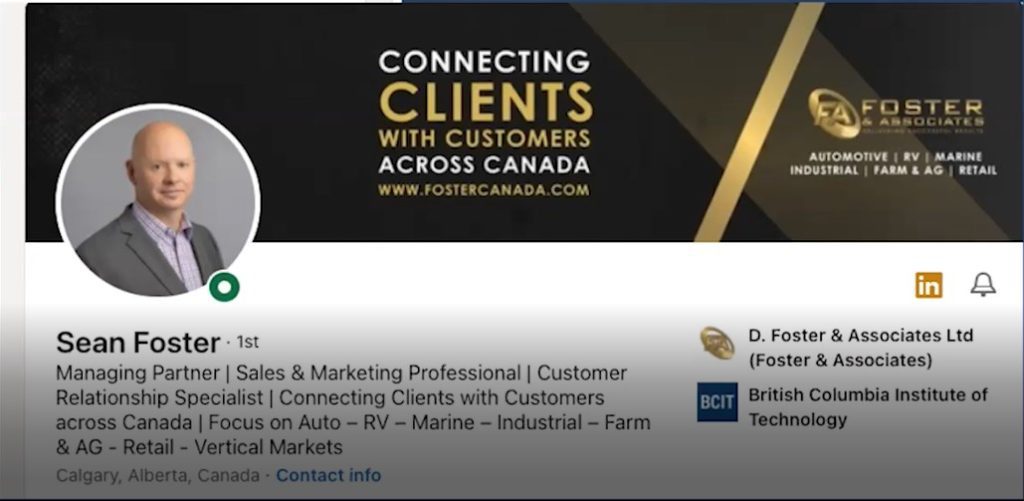
Again, he did that same thing, managing partner in the name of his company. That doesn’t tell us anything of itself or more than just that he’s one of the managing partners in the company. He and his brother both worked with me, and they have completely they have similar headlines, headers or banners, and their message is a little different because of their roles in the company, but it feels the same as their website. here, Sean is saying managing Partner Sales and Marketing Professional Customer Relationship Specialist. And then his statement, connecting clients with customers across Canada he focuses on and then he lists the vertical markets that they work in.
There’s a lot more information right there in that first impression, plus an updated headshot.
This is another client, just to show you that she was very clear. It matches her website. Look, she’s got her logo and the name of her company and her benefit statement. She also has her URL here. And although she has these lines behind her picture, it doesn’t fight with her headshot.

Now after your three headlines and headshot, the fourth H is called The Hook. I call it The Hook because it’s the beginning of your about section, and your about section is your narrative. This is the piece that people if they’re looking to do anything or to find out anything about you past that first impression, this is where they’re going to go. Your About section, used to be called the Summary, and your about section is in first person, and it’s in first person because it’s your narrative.
It’s not a resume. It’s not a cut-and-paste from your resume. This is an example of one. Notice that you have one, or two, and then the space is three. And this is four.
You have four lines on a desktop. You have two lines on a phone to read this before you see the see more button on somebody’s profile. If you can build curiosity and have them want to click more, then that’s what you want to do here. And this one doesn’t quite finish here. But she says, I love puzzles, and nothing fascinates me more than a business with a marketing or sales problem that needs to be solved.
During my years as a sales rep, I’ve had the opportunity to work with small businesses that have struggled with their offline and online marketing. I prefer it to be finished, but that’s what she did. Now the hook starts. The part of your About section. That’s a three-part formula in my estimation.
Here’s another one. I like this one better. Are you looking for a realtor who gets you? I work with people, not transactions. I don’t view real estate as deals to be one.
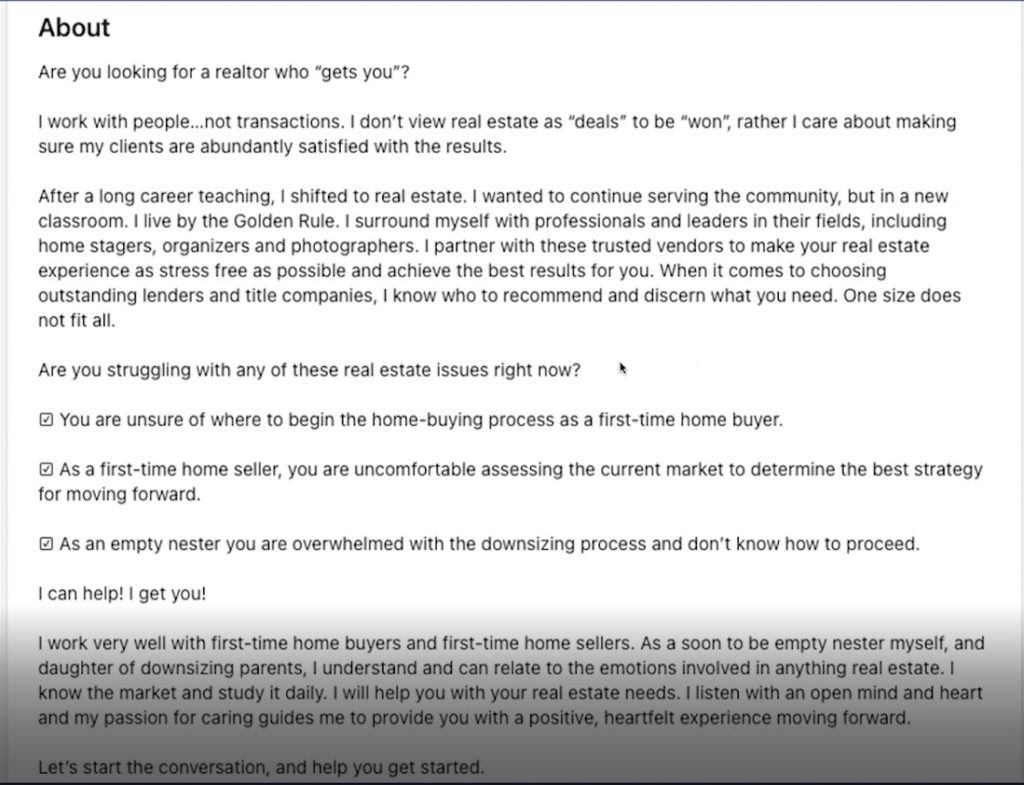
Rather, I care about making sure my clients are abundantly satisfied with the results right away. You know, this is a realtor who gets you, right? Who thinks about people, not just about the sale? If that’s what you think about, then you’d want to read more. And I love that she did that.
So, the first four lines are before the “see more,” and then she goes into a little bit about her background.
After a long career teaching, I shifted to real estate. I wanted to continue serving the community in a new classroom. I live by the golden rule. I surround myself with professionals and leaders in their fields, including home stages, organizers and photographers. I partner with these trusted vendors to make your real estate experience as stress-free as possible and achieve the best results for you.
When it comes to choosing outstanding lenders and title companies, I know who to recommend and discern what you need. One size does not fit all. Now, that tells you about her values and her philosophy around what she does, which is kind of the first piece. For some people it’s easy. For some people, it’s more of it’s important to show their background and the years of experience they’ve had.
I work with my clients to build this section with them and bring it out of them so that it makes sense. Then the second part of the three-part format is what I call client-facing. Are you struggling with any of these real estate issues right now? One, two, and three. They’re the issues that speak to who their target audiences are and what their pain point might be.
So they’ve listed them as a first-time home buyer, a first-time home seller, or an empty nester and the piece that may be frustrating them. So then they say, I get it. I can help you. And then she does a little bit of a summary there.
It doesn’t have to be as long as that. And then the last piece of the three-part format, which is not quite all there in this cut that I made because it has her contact info. But it’s let’s start the conversation and help get you started. It’s the call to action. It’s: here’s my number, here’s my calendar link, whatever it is so that they can start the conversation with you.
It’s so much more than just plopping your bio into this part of LinkedIn. It’s about having a conversation with people. It’s kind of written in storyteller style as well. It’s more inviting as well if you are speaking to your target audience because people will self-select if they see that you’re not their person, but if they’re curious and they see that you speak their language, they will be. And that’s why I’ve become quite comfortable saying to audiences that I’m all about relationships.
That’s the piece I focus on when I’m using LinkedIn because some people are more about content. They love to write, and it works for them. That’s not who I am. So, I mean, I do post occasionally, and I know the ins and outs of what’s important when you’re posting, but that’s just not my specialty if that makes sense.
So when you’re looking at you can see my headline there, by the way. LinkedIn Trainer Relationship Marketing Specialist podcast host and guest and then my benefits statement, increasing your sales by building relationships online and nurturing them offline.
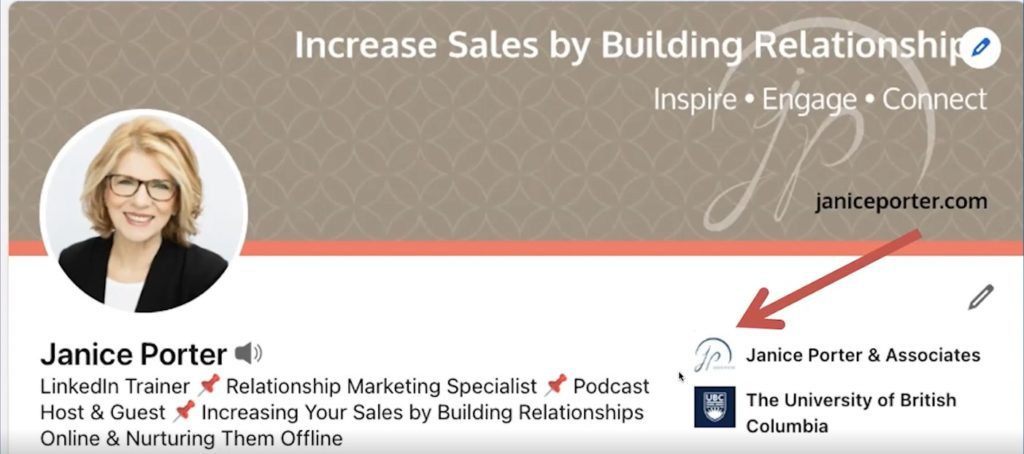
Seek out recommendations and endorsements
Recommendations from others in your field can add credibility to your profile. You can also endorse others for their skills, which is a nice way to reciprocate when someone recommends or endorses you.
What LinkedIn would suggest, and I would suggest instead of using your valuable real estate, you get people to give you recommendations. Recommendations on LinkedIn are the highest form of flattery, and they are social proof. if you go down to the bottom of my profile, I’m going to say to you, if you’re thinking about working with me, go to the recommendations on my profile or the testimonials on my website, but on LinkedIn, they’re called recommendations.
And what you see are the most recent three. And then you’ll see I have another 121 of them under here. You can look at any one of these people and look at their profiles and see how we work together. Or you can say, introduce me to so and so. I’d like to ask them how they worked with you.
You also need to make sure you have new recommendations and that they are not 10+ years old. You’ve got to keep something current out there. Remember the top three that show are ones, that’s what you see.
Be Authentic
What do we mean by authentic? How do you know when you are being authentic? There is no authenticity meter on LinkedIn. But we do know don’t we when someone is being authentic?
Let’s start by reminding ourselves why we are here. LinkedIn is a professional networking platform whether we are looking for a new job or a new customer we are here to promote ourselves and find new opportunities. People who are successful on LinkedIn understand that it is primarily a relationship-building tool. We do business with people we know, like and trust, who can bring value to our businesses. The way we represent ourselves on our profile or in our posts can build or destroy that trust.
To show people who you are, you need to dig into your character traits, values, and skill sets and make sure that the image you’re painting for viewers represents you. The more authentic you make your profile, the more value your connections will have to you. You only get one chance to make a first impression. Be true to yourself and allow your readers to get a feel for who you are.
If someone is prepared to show a little vulnerability and tell us something a little more personal about themselves that helps us to relate to them and builds trust. It could be a light-hearted anecdote or the story of a life-changing challenge that they overcame but this is LinkedIn, not Facebook, so it does need to be framed in a business context e.g., the lessons learned.
Build relationships
Connect with people you know. LinkedIn will suggest people you may know based on your current connections, so start with those individuals. Once you’ve connected with them, you can explore their networks and connect with some of their contacts.
I recommend that anybody with over 2000, even 1000 connections, when was the last time you talked to them? Here’s an example of a message you could send to people that are already your first-level connections. I know it’s been a while. I’m making a concerted effort to reconnect with my LinkedIn connections. I hope you’re doing okay as we begin to re-emerge after these crazy couple of years.
If you’re open to a catch-up call, that would be great. Looking forward to your reply and booking a time to talk.
Yeah, it’s simple, right? And it works. I got to tell you it works because if you’ve got 60 connections and you get 5 people that say, yeah, let’s have a conversation, you’ve got warm calls, right, that you can explore possibilities with. So that’s one thing. So now you can also look at new connections.
So when you’re looking at reaching out to new people, you have to think, who’s my target audience? And be clear about exactly who you want to connect with. You want to focus on second-level connections. And I’m going to show you what I mean by this. And target active users by always sending a personalized note.
With the second level connection, you actually can leverage common connections. So let me show you what I mean.
I just opened LinkedIn and I had one of those messages from somebody who was like, hey, I’m reconnecting with people. What have you been working on? I haven’t talked to her for months.
And you can personalize a message that fits you, but when you’re sending those to the people that you already know. But let’s say I want to search, and I want to search for I’m just going to go to the search people here. Okay, so let’s say I want to search for Realtors.
Now I can say realtor or real estate agent. And notice I did the R in capitals. And that’s a boolean search feature that allows you to if they have the word Realtor or they have Real Estate Agent in their profile, it’ll pick one of those, like either or. To see all results based on just my connections.
Now I start to filter it down to only my second-level connections. I want to be specific and only deal with Canadians, or I could go to a state like California.
I can still filter down by company if I want to, but I think for now, maybe I’ll do EXP, the newest one.
You can filter down by company size, titles, salaries, and different things that you can do. But there are a couple of other neat things you can do here, just with the basic LinkedIn. If you’re doing outreach and you’re looking for Realtors, the first thing you’re going to notice is look at their picture.
I’m looking at their first impression.
How many connections do they have? More importantly, are they active on LinkedIn? Because they aren’t and I send a message, they probably won’t see it.
But if they are active and this shows me that they posted two days ago and then a week ago, and if I hit show all activity, I can see all the stuff in their news feed. Right.
So why is that useful? Because it gives me something to talk about, and it shows me whether I want to reach out or not based on their activity.
The last thing I look at, is do they have any recommendations? I was to reach out to connect, because I think they are a prospect for my business, if I’m on a desktop, I’m going to hit the connect button, and then I’m going to add a personalized note. That personalized note does not need to be huge because all we’re getting them to do is accept, and they, unlike me, would probably just hit accept or ignore.
I would say something like “I’m expanding my reach to Realtors in the Canadian market. Would you be open to connecting here?”
And then I would go back to my search, and I would do the next one, and I’d look at it and so on. It seems tedious, but it’s better than wasting your time. If you’re going to do it yourself, then you need to see what the people are about. If you come back and the notification says they’ve connected with you, then you go to their profile and do a thank you message and you start the conversation.
You can also request personal introductions when appropriate. If there’s someone you want to connect with but don’t have a connection to, ask one of your common connections to introduce you. This creates a warmer introduction than simply sending a LinkedIn invite cold.
Use the Platform Consistently
As we discussed, keeping your profile up to date is an important part of using LinkedIn. As you are continually doing outreach and sharing content, people are going to visit your profile. Make sure you have an intriguing headline, a recent headshot, and a nice background photo to tie it all together. Also, make sure that your experience is listed correctly and that your About section tells your target audience who you are and what you do— people will be more likely to engage with you.
Keep your activity level up by regularly logging in and interacting with your network. The more active you are, the more likely people are to remember you and think of you when opportunities arise.
Writing articles is also a great way to establish yourself as an expert in your field and attract new connections. Share other relevant articles from around the web on your LinkedIn profile. This shows that you’re actively engaged in reading and staying up-to-date on trends in your industry.
Your LinkedIn Company Page or you personally will benefit from sharing 2-3x per week rather than randomly throughout the month. Take the time at the beginning of the week to plan out your content with captions. Scrambling for content to put up just to say you did it is not going to benefit your page. Sharing, liking, and commenting on your connections’ content is also beneficial.
You can get more leverage around a post that was good. For example, if you have a post that is getting a lot of traction or an event that’s coming up, you can add a featured section to your profile so that instead of it just going on the news feed and being gone in 3 seconds, you can pin it on your featured section.
Be Visible to Show your Authority
Increasing your visibility on LinkedIn by having a client-oriented profile, posting regular content, and engaging with your connections will ensure that you never miss out on these golden opportunities.
Leaving a meaningful comment on others’ posts is one of the easiest ways to start getting more comfortable with sharing content and being more visible on LinkedIn.
When you comment on a post or create a post yourself, the likelihood that people outside your network (those second- and third-degree connections) will see your post increases and so does the opportunity for building your network and subject-matter authority, as well as other potential opportunities.
If you see people liking or commenting on your posts, why not connect with them? This is an easy and strategic way to expand your network.
Another thing you can do is when you post content or a webinar, also post it in LinkedIn groups.
To find the right groups, look at the groups to which your peers and competitors belong and then join them. You can also find relevant groups in the main search bar on LinkedIn.
LinkedIn is a powerful tool and one that’s easy to use and take advantage of. You want your page to be visually appealing to visitors while making it easy for them to get a feel for who you are and what you really can do for them professionally. These five tips make a great start for building your winning LinkedIn profile.
—
By following Janice’s tips, you can make the most of LinkedIn as a networking tool. Building relationships with other entrepreneurs can give you access to valuable resources, advice, mentorship, and more. But it all starts with taking that first step and creating a profile that showcases your experience and expertise.
I’d love to hear how you apply the five steps to making LinkedIn work for you: creating your best first impression, being authentic, building relationships strategically, using the platform consistently, and being visible to show your authority to get Success on LinkedIn. Leave me a comment on how it went for you or drop any questions you want me to answer!
—
Follow Janice on Facebook
Follow Janice on Instagram
Connect with Janice on LinkedIn
